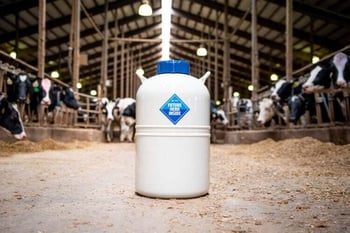There’s no other dairy farm in the world exactly like yours. So it’s important to ask yourself a couple questions to determine your ideal breeding goals and genetic plan.
You could use one of the US industry standard indexes to select the genetics for your herd. Their split weights on production, health and conformation will certainly help you make genetic gains in your herd. But will that progress actually match your farm’s current situation and future plans?
As a reminder, the following charts show the weights for the two most common US genetic indexes.
TPI
NM
Since your farm is unique, your best option is to create your own customized genetic plan to get the right genetics to match your goals.
Ask yourself these two important questions to decide which traits to emphasize in your genetic plan.
1. How do you get paid for your milk?
The majority of dairy producers make their main profit from the sale of milk. How that milk is priced varies greatly from one part of the country to another. Most milk produced in Florida is sold for fluid consumption, while much of Wisconsin’s milk goes into making cheese. The milk from some farms goes strictly into butter. Others’ is made into ice cream. Many cooperatives also pay premiums for low somatic cell counts.
Regardless where you ship your milk, the simple way to maximize your milk check is to select the right genetics to match your situation. To explain this, we focus in on the production traits of your genetic plan, which include milk, fat and protein.
If your farm’s milk is made into cheese, you’re likely paid on components, rather than total fluid volume. In that case, selection emphasis on protein will garner your greatest return on genetic investment.
If you farm in a fluid milk market, strict selection for NM$ could actually hinder your progress since NM$ includes a negative weighting on total pounds of milk.
Management practices play the largest role in the performance you see, but the right genetic choices will aid your future profit potential. For example, it takes top-level management practices to achieve ideal somatic cell counts. Yet, if your milk company offers milk quality premiums, genetic selection for low Somatic Cell Score is a logical choice to boost the benefits of your management even further.
Don’t leave dollars on the table. Within your genetic plan, make sure you emphasize the production traits to match how you get paid for your milk.
2. Why do your cows leave the herd?
Regardless if you are in expansion mode or maintaining steady numbers, some animals will leave your herd for one reason or another.
If you’re gradually growing to prepare for a future expansion project, you’ll benefit from heavier genetic selection emphasis on traits like Productive Life. This will keep your cattle numbers on the rise by creating healthier, longer-living cows.
Selection for CONCEPT PLUS high sire fertility will help you create more pregnancies now. Selection for fertility traits like Daughter Pregnancy Rate will help you create a next generation of more fertile females. If you focus on both male and female fertility you will end up with the additional replacements you’ll need.
On the flip side, if your farm is at max capacity with more replacements than you can accommodate, different traits will make a more profitable impact. If your farm sells extra springing heifers or fresh two-year-olds for dairy purposes, you know that buyers choose the stronger, well-grown animals with ideal feet and legs and favorable udders. In that case, a heavier selection emphasis on Udder Composite and Foot & Leg Composite can provide profitable returns on your genetic investment.
However, when your herd size is steady and you don’t sell extra heifers for dairy purposes, it’s important to question your selection for conformation traits. How many cows have you culled in the past year for poor udders or feet and legs?
If the answer is none, you could be limiting your future profitability.
AI companies already provide you with a high level of selection intensity for conformation. Their sire criteria often uses those industry standard indexes with 26% or 16% emphasis on conformation.
If you emphasize conformation traits, but you don’t cull any animals for poor udders or feet and legs, you are missing out on future profits. When you put your weight on conformation, your sacrifice extra selection for production, improved health and additional pregnancies.
Consider your genetic plan
There’s no other dairy in the world identical to yours.
Keep that in mind as you choose the genetics to create your next generation. While industry standard selection indexes can improve your genetics, they don’t necessarily align with your farm’s situation and goals.
Think about how you get paid for milk and the main reasons that cows leave your herd. When you customize your genetic plan to fit your farm’s needs, you will maximize your future milk checks and minimize your involuntary culls.



